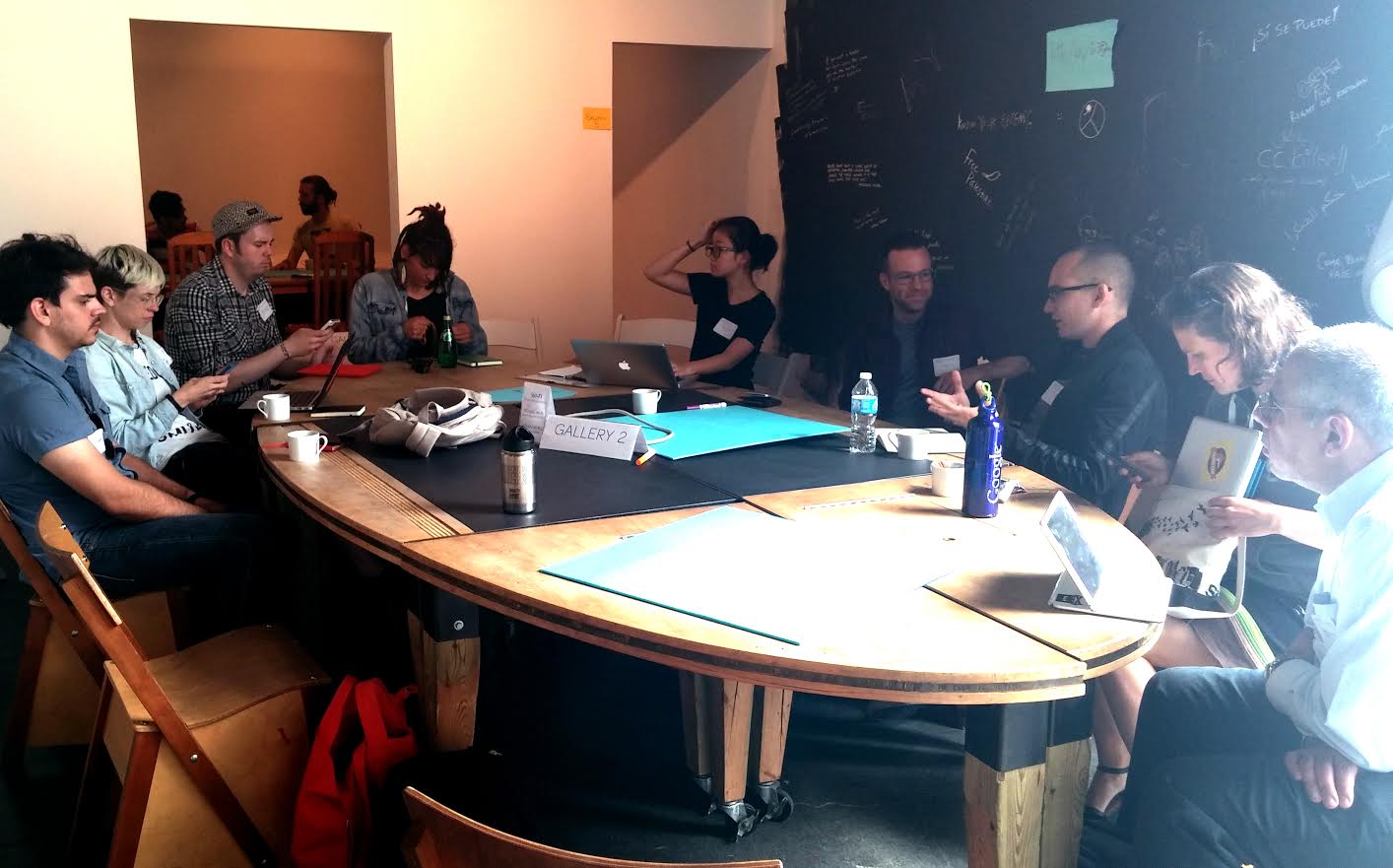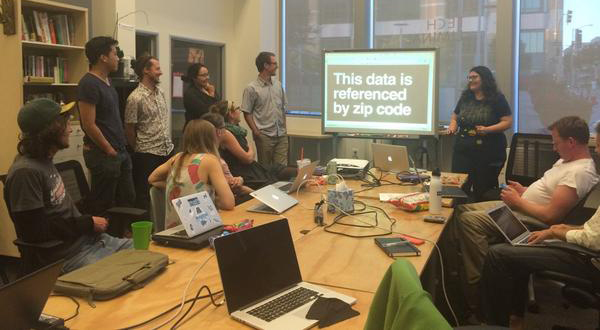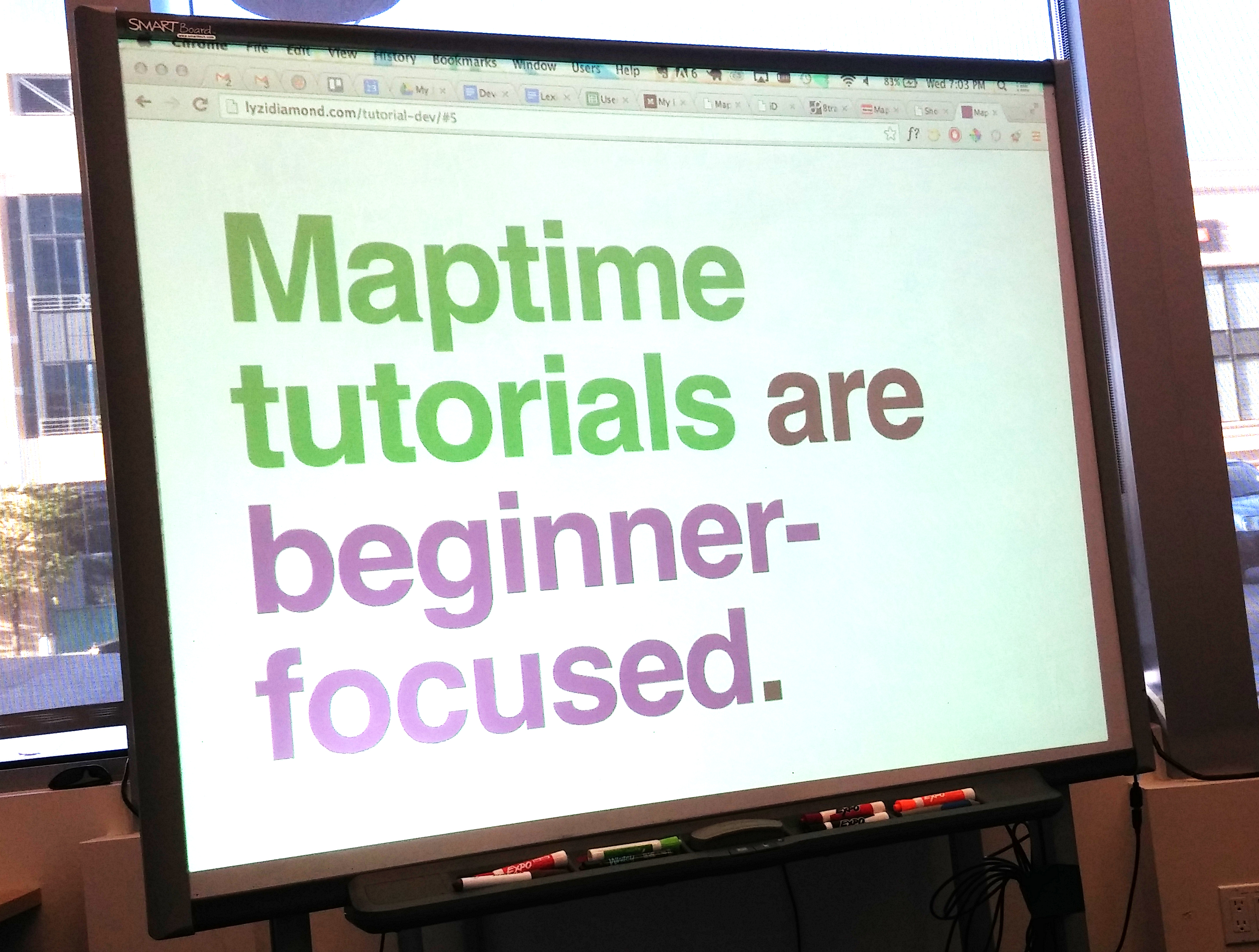Self-Organizing New Media Communities - A Discussion from Code+Ed
by Beth Schechter and Sands Fish
At Maptime Oakland last Wednesday, Lyzi presented a workshop about how to create tutorials for Maptime and beyond. After a brief (and wonderful) presentation covering some key components for success – like including term definitions and defining audience – she had people break into groups and co-create their own tutorials around topics of interest, like color theory for maps and basic CartoDB. As everyone was packing up, someone proposed an idea: to create a Maptime tutorial devoted to organizing people around a topic they would like to learn.
In addition to making my day absolutely and completely, the evening inspired me to want to finish and publish this blog post, which I’ve been working on with Sands Fish since we met at EYEO’s Code+Ed unconference back in June. To anyone looking to start their own meetup, this one’s for you! I’d love to shift it from advice column to tutorial one of these days, too.
Many thanks to Sands for initiating the idea in the first place, and to Ian Johnson, Sara Corrigan-Gibbs, John Hanawalt, and Jer Thorp for their contribution and review.
**
No matter where you are, but particularly if you are in a city or large town, chances are good you’ve encountered or at least heard of a meetup: some kind of social gathering organized around a community or topic, often accompanied by pizza and beer or another snacky combination. It’s such a simple concept, and yet anyone who puts one of these together can tell you that it’s more than just coordinating a space, speakers and snacks.
Last month, the EYEO Festival kicked off with an event called Code+Ed, a day-long unconference focused on the diverse space of creative coding education. Some of us who run meetups in the code / education / do-gooder space managed to find each other and have a conversation about our experiences and how to make our code-learning gatherings even better.
 Not surprisingly, this table full of code + education lovers had a lot to learn from each other. A couple of us decided to summarize the conversation, and to pass it on to you. Incomplete and in no particular order, here are of the best lessons and advice we came away with, as well as a few questions we are left to ponder.
Not surprisingly, this table full of code + education lovers had a lot to learn from each other. A couple of us decided to summarize the conversation, and to pass it on to you. Incomplete and in no particular order, here are of the best lessons and advice we came away with, as well as a few questions we are left to ponder.
Choose Your Community Model Wisely This one might sound like a no-brainer, but it speaks to an important point: the intention of your meetup. Do you want networking, connections and discussion, or listening, experts and Q&A, or something else entirely? Think about how your setup matches the experience you hope your guests will have, and consider how you can change that setup to evoke novel forms of participation.
Also keep in mind that this doesn’t have to be a final decision. If it makes sense, co-design the experience with the group. Make adjustments based on what works and what doesn’t. A healthy community is a fluid one.
When It Comes To Getting The Right People, Ask And You Shall Receive A good part of the discussion focused on how to reach out to the “right” people, find the appropriate edges of a community, and generally provide an inclusive atmosphere for anyone who wants to contribute or simply attend. Jer Thorp, one of the group’s attendees (who also helped to start EYEO) shared a simple technique he’s used for his meetup Random Awesome: Put a call out to all kinds of people in your communications, specifying randomly awesome categories as a way to illustrate the inclusiveness and inviting nature of the group. One time they called out to astronomers, which actually netted them an astronomer! He also cited “curating weird speakers” as a reason for the well-balanced crowd that attends EYEO.
Maptime has a similar strategy to ensure getting the right mix. We use the phrase “All beginners most welcome!” This ensures that people who show up will likely be beginners, if not beginner-friendly and (hopefully) beginner-helpful.
Choosing whether you want your meetup to be open to the public or more closely curated may also affect your choice of whether to post something on a forum like Meetup.com or to let the group grow offline. Choosing whether you want your meetup to be open to the public or more closely curated may also affect your choice of whether to post something on a forum like Meetup or to keep the group offline altogether.
Proceed With Caution Into Webcasts And Hangouts The group that gathered was an experienced one, and yet none of us have mastered the technological art / wizardry that enables creation of the perfect webcast or hangout, especially without appropriate AV equipment. Challenges like sound and video quality, post-editing, extension cords, etc. can be a real distraction and time-suck when you’d rather be focused on making sure the event is running smoothly.If you’re going to do it, find a person who knows what they’re doing and actually has decent equipment. Simply pointing your laptop at the speaker and just hitting Record is generally a waste of time and energy, with frustrating and low-quality results.
There was also conversation about whether recording is even a good idea in some situations. Does offering a webcast of the event disincentivize attending the actual event? Is it more important that people be present and participate than it is to reach a wide audience? These are questions worth considering when deciding whether to invest the time and effort in recording an event.
Create a (Reasonable) Barrier To Entry To Keep The Quality High The conversation also turned to the benefits of small, healthy barriers to entry, and in particular, ones that are matched to the community. Ian Johnson, who organizes the D3 User Group in San Francisco, described his small barrier of entry to the D3 unconference earlier this year: all attendees had to submit a small amount of code to register.
This activity helped to keep the conversation among coders of all levels and provided a better conversation for everyone. It also has the benefit of helping people to feel like they’re involved before the actual event, encouraging them to be a bit more invested in attending and participating.
Show & Tell! In learning scenarios, most people probably have a project of their own. Show & Tell (yes like the one you did in elementary school) allows everyone a chance to share their work and get feedback from the group. It also creates a human connection between the work and the idea of the work, which can be very different when you’re first learning.
There is also something extra inspiring about seeing your peers get up and share, rather than just people perceived as experts giving full talks. It makes learning seem less intimidating, because that person up there is learning just like you are. Show & Tell can also result in community connections and collaborations and instill a sense of pride in the community. Sands notes that after last year’s Boston Creative Coders demo party, the increase in energy in the community was very apparent. It made people feel like they belonged to something bigger than a monthly meetup. (Which they are.)
Make time for Documentation As a wonderful professor once said, “If you don’t document it, it never happened.” This is just as true for learning communities as it is for anything else (like that 2006 vacation in Italy…damn old-school iPod syncing shenanigans!). Sara Corrigan-Gibbs and John Hanawalt of Elefint Designs discuss how documentation for Desgn.it Tahoe helped to capture the experience and share it with the world. Ian’s d3 group hires a videographer to record all the talks given and puts them up on Youtube. These things are helpful both for letting potential members what the community is about, and for spreading the value beyond the local zipcode for things that are interesting to people worldwide.
If You Want Diversity, You Have To Make Space For It Of everything we talked about, it became clear that creating diverse communities is one of the biggest challenges. How do you expand beyond your bubble? Will you break it?
Jer mentioned the Jane Jacobs book he had been reading, The Death and Life of Great American Cities. In it, she states “Cities have the capability of providing something for everybody, only because, and only when, they are created by everybody.” He pointed out that notions of diversity similar to the kind Jacobs was writing about may also apply to thinking about creating diverse events. Diversity is necessary to a thriving city and neighborhood, and can also bring out the best in creative meetups. However, to create truly diverse spaces, they need to be created with the people who are going to be participating. Otherwise, it feels like someone else’s party, city, or world. “If I can’t see it, I can’t be it.”
He also admits that EYEO is still not as diverse as it could be, but everyone would like it to be. Now it’s just a matter of figuring out how to get there.
In addition to questions about diversity, there were some other big questions that we didn’t settle on answers for:
How Do We Build Smaller Groups From Larger Ones? Sometimes in learning communities, having too many people can be tricky to manage. How can your group benefit from new energy if it’s always the same people? What happens when there are more people than your space allows? What happens when there are more students than a single teacher can handle?
Sometimes, spinning off small groups is the best way for interested people to benefit from the community. These smaller groups can also contribute back to the original community if they go well. From the Boston Creative Coders community, Sands and friends started a small, 3-person study group to read a book together with the simple rule that everyone needed to have created something to show at each meeting, no matter how small. This may not have worked in a large group, but managing the project discretely made it very rewarding for those involved.
Where Does Money Fit In And How Does Sponsorship Affect the Community? Desgn.it – a series of events that pair good causes with designers, run by Elefint and mentioned above – has a great model for their weekend-long sprints: nonprofits with limited budgets invest what they can in the project, which Desgn.It uses for food and lodging for volunteer designers to use all weekend.
For the last Desgn.It weekend in Tahoe, Desgn.it charged about $4,000 per organization for the weekend. Although the primary purpose of this money was to provide the house and the food for the weekend, there was a valuable side-effect of the payment as well: the organizations feel more invested, bring their “A” games, and make sure to send their organization’s important decision makers to the event. Conversely (and interestingly) this kind of payment structure may also affect organizations’ desire/ability to attend, especially when working in the nonprofit (i.e. usually fairly low-budget) space.
All in all, the model works for services, but would it work for community education? There’s still a lot to learn here.
And there’s also one more question to answer: How do we self-organize new media communities?
Not to ask yet another question, but what even is self-organization? Wikipedia tells us that “Self-organization is a process where some form of global order or coordination arises out of the local interactions between the components of an initially disordered system. This process is spontaneous: it is not directed or controlled by any agent or subsystem inside or outside of the system.”
This description fits how Maptime got started, and likely how other communities have gotten started as well. But after the initial burst of energy, and certainly at a certain scale, the need for some kind of organization emerges and more conscious organization patterns begin to take shape. Maptime strives for just enough organization to provide scaffolding for communities all over to build on, while having enough freedom to innovate and be creative. In this way it is an organization to create a framework for self-organization.
So to answer the question: self-organization happens naturally. If we love it, we keep on doing it, and then we organize.
No matter how you slice or define it, organization takes work, and sometimes a lot of it. We hope some of the questions and ideas above will help you to healthily and dynamically manage and participate in your own.
Have other ideas about community building and diversity in the new media space? We’d love to hear them! Leave comments or reach out to Beth (@bethschechter) or Sands (@sandsfish). We’re excited to further this discussion!
Sands Fish is a fellow at Harvard’s Berkman Center for Internet & Society and a research affiliate at the MIT Media Lab’s Center for Civic Media, where he focuses on data mining and visualization of the digital public sphere.
Special note: this blog post is dedicated to friend of Maptime and amazing data visualizer Zachary Watson. We all wish you a speedy recovery from your very unfortunate accident. To all the cyclists out there, please be safe!


